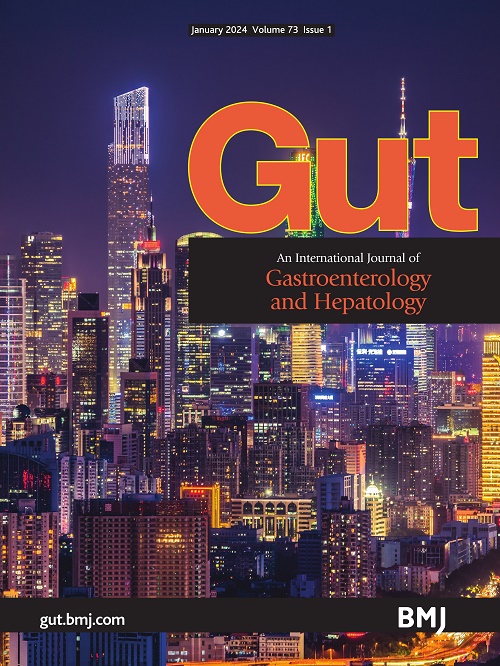Microbiota-induced S100A11-RAGE axis underlies immune evasion in right-sided colon adenomas and is a therapeutic target to boost anti-PD1 efficacy
IF 23
1区 医学
Q1 GASTROENTEROLOGY & HEPATOLOGY
引用次数: 0
Abstract
Background Tumourigenesis in right-sided and left-sided colons demonstrated distinct features. Objective We aimed to characterise the differences between the left-sided and right-sided adenomas (ADs) representing the early stage of colonic tumourigenesis. Design Single-cell and spatial transcriptomic datasets were analysed to reveal alterations between right-sided and left-sided colon ADs. Cells, animal experiments and clinical specimens were used to verify the results. Results Single-cell analysis revealed that in right-sided ADs, there was a significant reduction of goblet cells, and these goblet cells were dysfunctional with attenuated mucin biosynthesis and defective antigen presentation. An impairment of the mucus barrier led to biofilm formation in crypts and subsequent bacteria invasion into right-sided ADs. The regions spatially surrounding the crypts with biofilm occupation underwent an inflammatory response by lipopolysaccharide (LPS) and an apoptosis process, as revealed by spatial transcriptomics. A distinct S100A11+ epithelial cell population in the right-sided ADs was identified, and its expression level was induced by bacterial LPS and peptidoglycan. S100A11 expression facilitated tumour growth in syngeneic immunocompetent mice with increased myeloid-derived suppressor cells (MDSC) but reduced cytotoxic CD8+ T cells. Targeting S100A11 with well-tolerated antagonists of its receptor for advanced glycation end product (RAGE) (Azeliragon) significantly impaired tumour growth and MDSC infiltration, thereby boosting the efficacy of anti-programmed cell death protein 1 therapy in colon cancer. Conclusion Our findings unravelled that dysfunctional goblet cells and consequential bacterial translocation activated the S100A11-RAGE axis in right-sided colon ADs, which recruits MDSCs to promote immune evasion. Targeting this axis by Azeliragon improves the efficacy of immunotherapy in colon cancer. Data are available on reasonable request.微生物诱导的 S100A11-RAGE 轴是右侧结肠腺瘤免疫逃避的基础,也是提高抗 PD1 疗效的治疗靶点
背景 右侧和左侧结肠的肿瘤发生表现出不同的特征。目的 我们旨在描述代表结肠肿瘤发生早期阶段的左侧和右侧腺瘤(ADs)之间的差异。设计 分析单细胞和空间转录组数据集,以揭示右侧和左侧结肠腺瘤之间的变化。使用细胞、动物实验和临床标本验证结果。结果 单细胞分析表明,在右侧结肠 ADs 中,鹅口疮细胞显著减少,这些鹅口疮细胞功能失调,粘蛋白生物合成减弱,抗原呈递缺陷。粘液屏障受损导致隐窝形成生物膜,细菌随之侵入右侧腹腔积液。空间转录组学显示,生物膜占据的隐窝周围区域在脂多糖(LPS)的作用下出现了炎症反应和细胞凋亡过程。在右侧AD中发现了一个独特的S100A11+上皮细胞群,其表达水平受到细菌LPS和肽聚糖的诱导。S100A11的表达促进了肿瘤在合成免疫小鼠体内的生长,同时增加了髓源性抑制细胞(MDSC),但减少了细胞毒性CD8+ T细胞。用耐受性良好的高级糖化终产物受体(RAGE)拮抗剂(Azeliragon)靶向 S100A11,可显著抑制肿瘤生长和 MDSC 浸润,从而提高抗程序性细胞死亡蛋白 1 治疗结肠癌的疗效。结论 我们的研究结果揭示了右侧结肠 ADs 中功能失调的胃小管细胞和随之而来的细菌转运激活了 S100A11-RAGE 轴,从而招募 MDSCs 促进免疫逃避。阿泽利龙以该轴为靶点,可提高结肠癌免疫疗法的疗效。如有合理要求,可提供相关数据。
本文章由计算机程序翻译,如有差异,请以英文原文为准。
求助全文
约1分钟内获得全文
求助全文
来源期刊

Gut
医学-胃肠肝病学
CiteScore
45.70
自引率
2.40%
发文量
284
审稿时长
1.5 months
期刊介绍:
Gut is a renowned international journal specializing in gastroenterology and hepatology, known for its high-quality clinical research covering the alimentary tract, liver, biliary tree, and pancreas. It offers authoritative and current coverage across all aspects of gastroenterology and hepatology, featuring articles on emerging disease mechanisms and innovative diagnostic and therapeutic approaches authored by leading experts.
As the flagship journal of BMJ's gastroenterology portfolio, Gut is accompanied by two companion journals: Frontline Gastroenterology, focusing on education and practice-oriented papers, and BMJ Open Gastroenterology for open access original research.
 求助内容:
求助内容: 应助结果提醒方式:
应助结果提醒方式:


